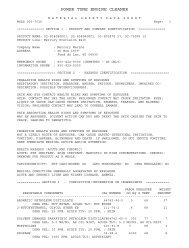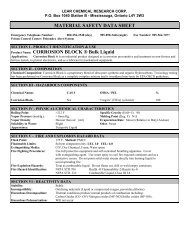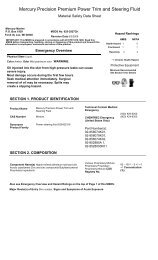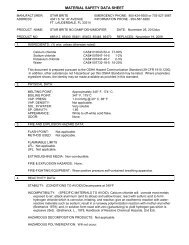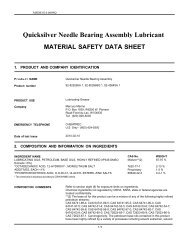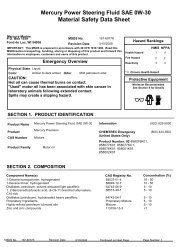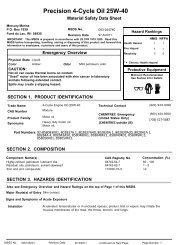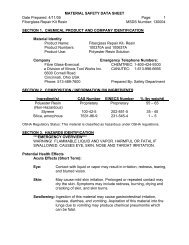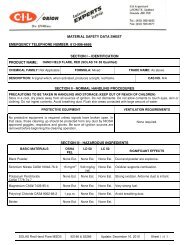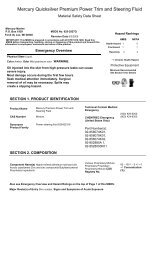Quicksilver Rejuvenate 2-Cycle Engine Oil - Mercury Marine
Quicksilver Rejuvenate 2-Cycle Engine Oil - Mercury Marine
Quicksilver Rejuvenate 2-Cycle Engine Oil - Mercury Marine
You also want an ePaper? Increase the reach of your titles
YUMPU automatically turns print PDFs into web optimized ePapers that Google loves.
<strong>Mercury</strong> <strong>Rejuvenate</strong> 2-<strong>Cycle</strong> <strong>Engine</strong> <strong>Oil</strong><br />
SECTION 3. HAZARDS IDENTIFICATION<br />
Also see Emergency Overview and Hazard Ratings on the top of Page 1 of this MSDS.<br />
Major Route(s) of Entry Skin contact. Eye contact. Inhalation.<br />
Signs and Symptoms of Acute Exposure<br />
Inhalation<br />
Eye Contact<br />
Skin Contact<br />
Ingestion<br />
Chronic Health Effects<br />
Summary<br />
Conditions Aggravated<br />
by Exposure<br />
Target Organs<br />
Carcinogenic Potential<br />
At elevated temperatures or in enclosed spaces, product mist or vapors may irritate the<br />
mucous membranes of the nose, the throat, bronchi, and lungs.<br />
This product can cause transient mild eye irritation with short-term contact with liquid sprays<br />
or mists. Symptoms include stinging, watering, redness, and swelling.<br />
This product can cause mild, transient skin irritation. The severity of irritation will depend on<br />
the amount of material that is applied to the skin and the speed and thoroughness that it is<br />
removed. Symptoms include redness, itching, and burning of the skin. Repeated or<br />
prolonged skin contact can produce moderate irritation (dermatitis).<br />
If swallowed, large volumes of material can cause generalized depression, headache,<br />
drowsiness, nausea, vomiting and diarrhea. Smaller doses can cause a laxative effect. If<br />
aspirated into the lungs, liquid can cause lung damage.<br />
Prolonged and/or repeated skin contact may cause irritation and inflamation. Symptoms<br />
include defatting, redness, dryness, blistering eczema-like lesions, scaly dermatitis, and/or<br />
more serious skin disorders. Chronic effects of ingestion and subsequent aspiration into the<br />
lungs may cause pneumatocele (lung cavity) formation and chronic lung dysfunction.<br />
Disorders of the following organs or organ systems that may be aggravated by significant<br />
exposure to this material or its components include: Skin, Respiratory System, Liver,<br />
Kidneys, Central Nervous System (CNS)<br />
May cause damage to the following organs: kidneys, liver, upper respiratory tract, skin,<br />
central nervous system (CNS), eye, lens or cornea<br />
This product is not known to contain any components at concentrations above 0.1% which<br />
are considered carcinogenic by OSHA, IARC or NTP.<br />
OSHA Hazard Classification is indicated by an "X" in the box adjacent to the hazard title. If no "X" is present,<br />
the product does not exhibit the hazard as defined in the OSHA Hazard Communication Standard (29 CFR<br />
1910.1200).<br />
OSHA Health Hazard Classification<br />
OSHA Physical Hazard Classification<br />
Irritant<br />
Toxic<br />
Corrosive<br />
Sensitizer<br />
Highly Toxic<br />
Carcinogenic<br />
Combustible X Explosive Pyrophoric<br />
Flammable Oxidizer Water-reactive<br />
Compressed Gas Organic Peroxide Unstable<br />
SECTION 4. FIRST AID MEASURES<br />
Take proper precautions to ensure your own health and safety before attempting rescue or providing first aid.<br />
For more specific information, refer to Exposure Controls and Personal Protection in Section 8 of this MSDS.<br />
Inhalation Move victim to fresh air. If victim is not breathing, immediately begin rescue breathing. If<br />
breathing is difficult, 100 percent humidified oxygen should be administered by a qualified<br />
individual. Seek medical attention immediately. Keep the affected individual warm and at<br />
rest.<br />
Eye Contact<br />
Check for and remove contact lenses. Flush eyes with cool, clean, low-pressure water while<br />
occasionally lifting and lowering eyelids. Seek medical attention if excessive tearing, redness,<br />
or pain persists.<br />
MSDS No. 625431316 Revision Date 6/3/2009 Continued on Next Page Page Number: 2



